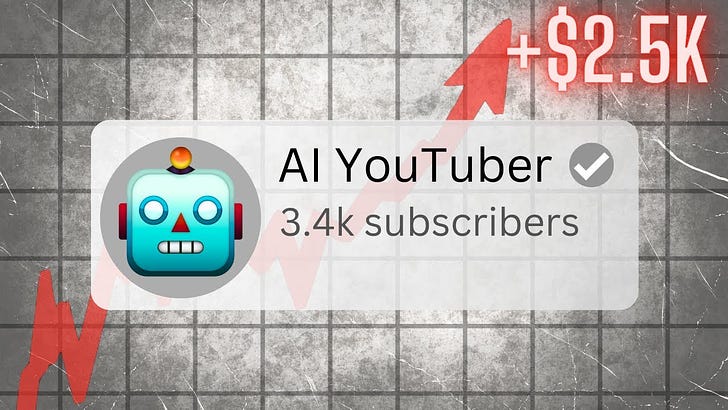This week’s issue is about YouTube automation: a trend that exploded in popularity with the release of ChatGPT and refers to YouTube videos written, voiced, and even animated by AI.
Creators in this space view automated channels as passive-income side hustles, and flaunt huge payouts for little to no effort. They refer to their channels as “cash cows.”
Colin and Samir recently published an amazing and in-depth discussion of the copy-and-paste culture of YouTube. In short, successful creators on the platform often see increasingly blatant mimicry of their work. One viral video from a creator begets tens of copycat posts with identical thumbnails, titles, and even verbatim reproductions of the content.
This reflects a long-standing ethos among up-and-coming creators: do whatever it takes to capitalize on a viral moment. Belief in the content doesn’t matter. Passion for the subject doesn’t matter. Love of the craft doesn’t matter. What matters are analytics and analytics alone.
There’s no denying that creating on the Internet is increasingly an economic proposition. These are not the innocent days of early YouTube, when creators like MKBHD found their niches and audiences through interest-guided trial and error, putting quality of output and relevance to their viewers above all else. They came to the platform and to the video medium primarily for love of the work, the process, and the substance.
I’m not a purist — I don’t think the introduction of big money to the creator economy is necessarily a bad thing. It provides opportunity and creative employment for brilliant filmmakers, writers, and creators of all kinds.
But YouTube automation takes the profit-driven “whatever it takes” philosophy to its extreme. Many YouTube automation gurus make no mention in their tutorials of interest, expertise, or even belief in the content. Their titles and thumbnails boast absurd monthly revenues for zero-effort side hustles (“$12,000 / month passive income”) and they determine their niches by searching for the highest cost-per-mille (CPM) — the dollar amount paid by advertisers for every thousand impressions. Higher advertiser spending means more AdSense revenue for these creators. Finance and tech fall at the high end of the CPM spectrum — and automated creators are more than happy to churn out AI-generated content in these niches, to dip their buckets in those steady streams of advertiser dollars.
In other words, for these creators, creating is nothing but a means to an end.
I could reasonably be accused of being overly romantic about this. But to me, automating what is essentially a communicative and expressive process feels blasphemous. Videos are a way of connecting with other people. They’re a medium of information exchange, sure, but so is text. Video, not text, is the Internet’s chosen medium because of its immediacy, its directness, and the visceral nature of a visual medium.
When viewed purely as a method for transferring information, the minimum quality control requirement is correctness. But AI-generated content is likely to contain falsehoods. When viewed as a method of creative expression, the minimum quality control requirement is conviction — the creator’s belief that the work is good, or good enough.
What strikes me as gross about this entire prospect is the mechanistic nature of churning out content with no human touch to capture as much of the human-attention commodity as possible. YouTube automation seeks only to maximize ad revenue and minimize effort: what happens in between is nothing but a formality.
To me, and I imagine to most creators on YouTube, what happens “in between” is not in between at all — it is the heart of the endeavor. It’s the reason for being on the platform at all: the videos are the end in themselves. We are driven to make videos by a genuine passion: whether it’s a message that must be shared, a love for the process that must be fulfilled, or an abiding curiosity for the subject matter that must be explored. The views, subscribers, and ad dollars support us so we can follow those passions.
I have nothing against using AI tools to clarify a script’s message, improve video title ideas, or reduce the big lift of a big edit. But I have everything against letting these tools cannibalize the entire process.
I hope sincerely that YouTube demonetizes these wholly-automated “cash-cow” channels pumping out meaningless videos to farm ad revenue. If not, these newly capable AI tools and long-standing bad incentives will only continue to align to disheartening effect.









